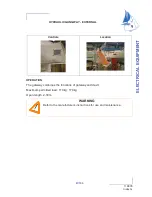
34
Second, turn the bilge pump off at the instrument panel and check the bilge pump float switch. Each pump is
equipped with an automatic float switch (white box) that is mounted next to the bilge pump. As long as your boat
is equipped with an operable battery, each pump will operate independently when water is present in the area.
Each float switch is equipped with two plastic knobs located on either side of the switch. Turn either one of the
knobs to raise the float to engage the bilge pump. If the pump comes on, the automatic float is operating
properly. It is recommended that you check the operation of each automatic float switch monthly.
Keep the bilge area clean and free from debris that could clog ports or inhibit float movement. Also, keep the
battery (starboard) that provides power to the bilge pumps charged. If the battery is not charged and flooding
occurs, the boat could swamp causing damage and possible loss of life or property. If for some reason the
indicator light on one of your bilge pump switches comes on, check your bilge for water. It is not uncommon for
rain water or water from washing your boat to accumulate in the bilge. Standing water will activate the automatic
float that is connected to the bilge pump. If you notice your pump running frequently during your day on the
water, you should check the thru hull fittings, hose connections, etc. for any possible leaks.
High Water Alarm
A high water alarm switch is mounted on the console and is wired to bilge pump 2.
The switch should be kept in the “Auto Alarm” position (to the left). When the
automatic float switch activates bilge pump 2, the alarm will sound. If the alarm
should sound, as a precaution, check the bilge area immediately to determine if
emergency action should be taken. The toggle switch may be turned to the
override position (to the right) to deactivate the alarm.
Fish Boxes with Macerator Pump
Your boat is equipped with port and starboard fish boxes with a
total capacity of 125 gallons. The macerator pump drains both fish
boxes and/or macerates any fish particles. The pump is located in
the bilge and is equipped with an automatic float switch. As the
fish boxes drain, water and/or debris travel to the holding tank
attached to the pump and then to the fish box macerator pump
which pumps the water and/or debris overboard.
The fish box macerator pump operates on a 2-way rocker switch
located on the switch panel labeled fishbox pump.
To properly operate the fish box macerator pump, fill both fish boxes with water. Then move the fish box switch
on the switch panel to the forward position to operate the pump. The water and fish particles will be pumped out
of the tubs and will be routed through the macerator pump and then overboard via the fish box thru hulls on each
side of the boat. When you are finished emptying the fish boxes, place the fish box switch in the aft position to
turn off the fish box macerator pump.
To check the system for drainage, remove the white 90
o
elbow fitting that connects the hose to the holding tank.
The fitting is held in place with a rubber grommet therefore no hose clamps need to be removed. After removing
the fitting, feel around just inside the holding tank for the 2 round plastic buttons (approx. ½” in diameter) and
simply lift the 2 buttons to check the operation. If the float is working properly, the pump will activate. On
occasion, you may find excessive debris in the holding tank that is causing a blockage. Just remove the debris
through this same opening. When you are finished checking the operation, reinsert the 90
-degree
elbow fitting back
into the rubber grommet until is seats itself.
Head Waste System
WHAT IS THE LAW?
Congress enacted the Clean Water Act of 1972 (amended in 1987). This law addresses a wide spectrum of
water pollution problems, including marine sewage from boats in navigable U.S. waters including coastal waters
















































